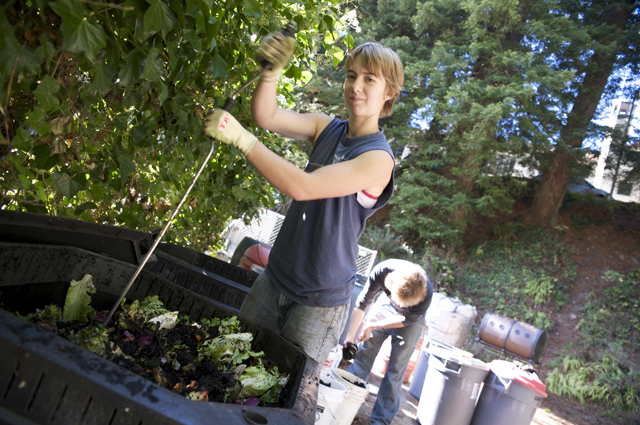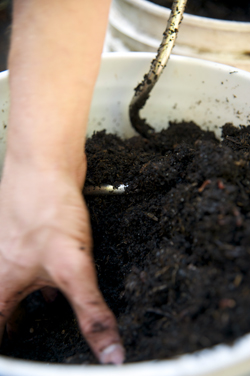
HSU is partnering with the Humboldt Waste Management Authority and Environmental Science Associates to divert 100 percent of the campus’s organic waste by December 2012. The initial 12-18 months of the program will be used to initiate the project and work out logistics.
As part of her work with the authority, alumna Juliette Bohn (‘10, M.S. International Development Technology) contacted TC Comet, director of HSU’s Office of Sustainability and invited the campus to participate as an early adopter of the food waste diversion program.
“For a long time, the Humboldt Waste Management Authority has wanted something in place that could deal with organic waste locally,” Comet says. “We’re a very large organic waste producer, so when Juliette asked me if HSU wanted to be an early adopter, I said ‘Of course.’”
Currently, the student-run Waste Reduction and Resource Awareness Program (WRRAP) keeps about 8,000 pounds of compostable waste out of the landfill annually. As part of the new food diversion program, Comet estimates that number has the potential to jump to 300 tons of organic waste diverted every year.
Pre- and post-consumer organic waste created at HSU will be collected from campus eateries like the “J” Cafeteria with the cooperation of Dining Services. “They’ve been willing to give their time and money to help with training and other changes,” Comet says. “They deserve a big thank you for their role in making this happen.”
Organic waste will also be collected from newly installed, wildlife-resistant compost bins placed around campus.
Upon its completion, organic waste collected from campus will be taken to the authority’s new anaerobic food waste digester. There, bacteria will break down the waste in an oxygen-free environment, resulting in two main byproducts.

First, the treated waste will produce methane, which will be used as a renewable fuel to create electricity. The resulting electricity will be used to power the Elk River wastewater treatment plant in Eureka.
Excess electricity will likely be put back into the grid and will be sold to the Pacific Gas & Electric Company to help offset the program’s costs. According to the authority’s website, one 12-ton truckload of food waste can produce enough energy to power 260 homes in Humboldt County for one day.
The second product of biodigestion will create a nutrient-rich fertilizer. According to the authority, that fertilizer can be used to return lost nutrients to local soils.
In addition to the renewable energy and fertilizer created by biodigestion, the program will also offset harmful environmental impacts of food waste in the solid waste stream.
Harmful greenhouse gases emitted by decomposing food will be sequestered in the biodigester, keeping them out of the atmosphere. Further reduction in greenhouse gas emissions will result from the shorter trucking distances required to move organic waste to the authority’s biodigester, rather than distant landfill sites.
Although the lion’s share of organic waste from campus will go to the biodigester, WRRAP will continue to maintain a demonstration-scale composting program. The new food waste diversion effort will also present an opportunity for students to increase the amount of outreach and education regarding food waste diversion.
Additionally, the partnership with the authority opens up further opportunities to explore and discuss the process and impacts of biodigesters on a large scale.
For more information about sustainability on campus, check out the Green Scene at humboldt.edu/green.
Learn more about WRRAP at humboldt.edu/wrrap.
For more information on the Humboldt Waste Management Authority’s Food Waste program, visit http://www.hwma.net/food-waste.